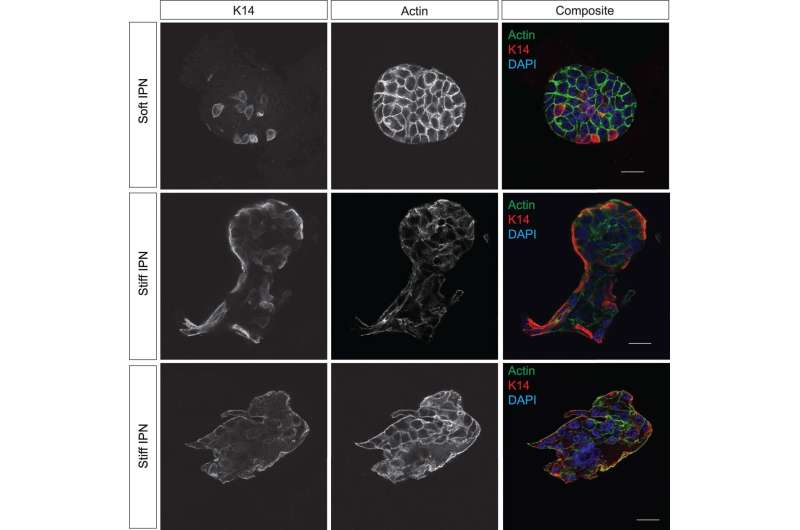This article has been reviewed according to Science X's editorial process and policies. Editors have highlighted the following attributes while ensuring the content's credibility:
fact-checked
peer-reviewed publication
trusted source
proofread
Study shows breast cancer cells collaborate to physically tear through barriers and spread

The majority of breast cancers start in the lining of a breast milk duct and, if they remain there, are very treatable. But once these cancers become invasive—breaking through a thin matrix around the duct, called the basement membrane, and spreading to the surrounding tissue—treatment becomes more challenging.
In a paper, published on Nov. 13 in Nature Materials, researchers at Stanford revealed a novel physical mechanism that breast cancer cells use to break out and become invasive. They found that, in addition to established chemical methods of degrading the basement membrane, cancer cells work as a group to physically deform and tear through the basement membrane barrier.
"When this invasion process has been studied, the focus has typically been on single cells," said Ovijit Chaudhuri, an associate professor of mechanical engineering and bioengineering, by courtesy.
"But what we know is that the invasion is actually collective in nature, involving groups of cells working together to penetrate through the basement membrane. Our work has elucidated how cells act together to break through the basement membrane, advancing our fundamental understanding of this critical transition in cancer progression."
A model for mechanical forces
Previous research has shown that individual cancer cells can produce enzymes, called proteases, that break down some of the basement membrane, but treatments inhibiting proteases haven't been able to stop cancer cells from breaking loose. Chaudhuri and his colleagues figured there must be other mechanisms at work, so they developed a new model to study breast cancer and the basement membrane in three dimensions.
"What we're really looking at are the mechanical forces involved, which is a different perspective," said Julie Chang, who conducted the work as a doctoral student in Chaudhuri's lab and is one of the lead authors on the paper. "The current paradigm is that cells use chemicals to degrade through the basement membrane, but we show that this physical aspect is just as important."
The researchers designed a 3D hydrogel that mimics the properties of breast tissue and cultured cellular structures, called acini, that exhibit features of a breast duct and are surrounded by their own basement membrane. They tagged the basement membrane with fluorescent markers so that they could see and measure any deformation as cancerous cells interacted with it. And what they saw surprised them.
The cancer cells trapped within the acini swelled together, causing the basement membrane to stretch like a balloon. This stretching process thinned and weakened the basement membrane, which allowed cancer cells near the membrane to apply additional forces to open holes and escape.
"The cells are expanding and increasing their volume in unison, and then locally pulling to tear up the basement membrane," said Aashrith Saraswathibhatla, a postdoctoral researcher in Chaudhuri's lab and co-lead author on the paper. "This collective volume expansion hasn't been predicted before—no one was thinking about it."
The researchers determined that key findings from their 3D model were consistent with what has been seen in patients with invasive breast cancers. They also consulted with colleagues at the University of Pennsylvania who were able to validate their results with computational modeling, confirming the physical forces involved could theoretically allow cells to break through the basement membrane.
From new mechanisms to new treatments
Understanding how cancer cells act together and the mechanical forces they apply could lead to new therapeutic strategies to block invasion. It could also help researchers determine which patients with pre-invasive breast cancer are most likely to have their cancer break out and spread, which could result in more targeted treatments.
While this work is just the first step towards these possibilities, the researchers are continuing to make progress in this realm. They are investigating how cancerous cells physically interact with the surrounding breast tissue once they break through the basement membrane and diving deeper into understanding the basement membrane itself—looking into both mechanical and structural features—to get more insight into why some tumors become invasive and others don't.
"This global volume expansion mechanism represents a new insight into how the breast tumors become invasive, borne out of the development of a 3D culture model that allowed us to visualize the invasion process," Chaudhuri said. "It highlights the emergent behaviors arising in groups of cells acting together that enable cancer invasion."
Chaudhuri is a member of Stanford Bio-X, the Cardiovascular Institute, and the Wu Tsai Human Performance Alliance; and a faculty fellow of Stanford Sarafan ChEM-H.
More information: Julie Chang et al, Cell volume expansion and local contractility drive collective invasion of the basement membrane in breast cancer, Nature Materials (2023). DOI: 10.1038/s41563-023-01716-9




















